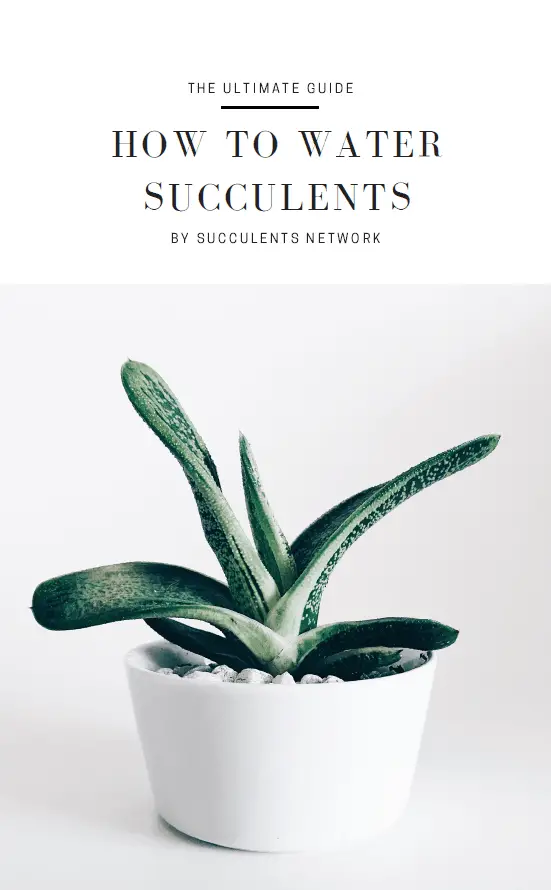Succulents are adaptable and durable plants that come in a myriad of colors and shapes. They received their name from the ability to store water in their leaves, stems, and roots, which is why they do not require frequent watering. As such, they are easy to care for and can flourish even in an indoor environment as long as you follow some basic instructions. Here’s how to grow and care for a succulent plant to ensure it a long and happy life in your home.
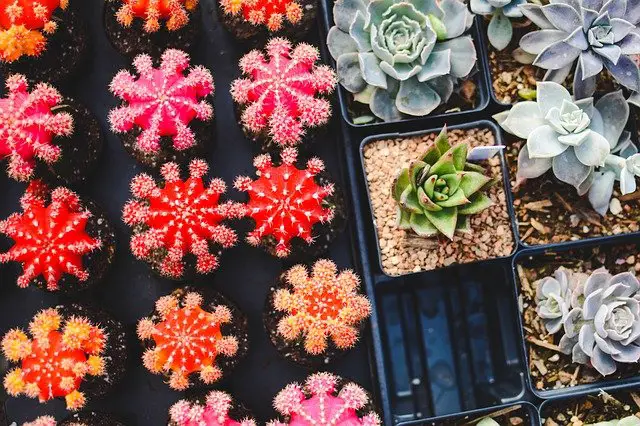
Picture via Pixabay
How to Create the Perfect Conditions for Your Succulent
The Best Pots For Succulents
Pots come in all sizes, shapes, and materials. Most pots made of plastic or ceramic and what you choose is a matter of personal preference. Succulents can flourish in pots made of various materials, but there are a few things you may want to consider.
Succulents grown in plastic pots typically require less watering while those grown in clay/ceramic (especially the unglazed ones) will require more watering. However, ceramic pots can provide more stability for large or top-heavy succulents. Regardless of what material you choose, make sure that the pot allows for good drainage.
The Best Soil For Succulents?
Proper soil is crucial for the survival of a succulent. The best soil for these plants is a well-draining potting mix that will prevent overwatering. There are many commercial soil mixes for succulents and cacti you can purchase, but you may find that some hold more water than you would like. You can easily make a homemade potting soil for your plant with just a few affordable ingredients.
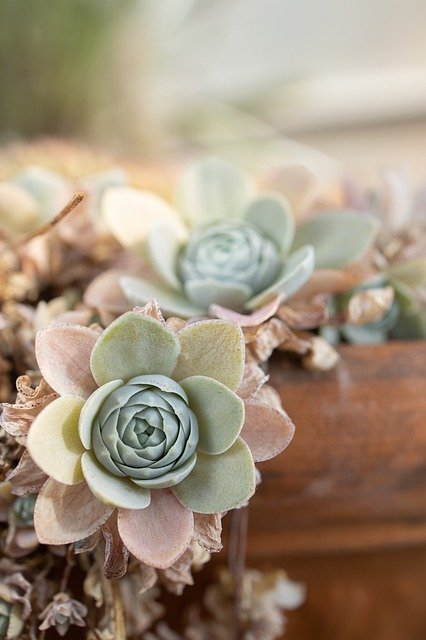
Picture via Pixabay
How To Make Homemade Succulent Potting Soil
Ingredients:
- Potting soil Perlite or pumice
- Coarse sand
Supplies:
- Measuring container
- Container for mixing
- Trowel
Any type of potting soil for indoor plants will do its job as long as it’s fresh and sterile. But when creating the potting mix for a succulent, it’s recommended to choose a light and porous soil as a base so that it doesn’t hold moisture.
Moving on to the sand, you could use just about any type of sand, but the best option is coarse sand rather than a fine one. Turface or poultry grit may also be used successfully instead of stand.
Perlite is an organic soil amendment that is used for preventing soil compaction and adding better drainage. As such, it helps the soil drain faster, which is what you want when you’re growing succulents.
Recipe:
- Three parts potting soil
- Two parts coarse sand/turface/poultry grit
- One part perlite/pumice
To mix all the ingredients together you simply need to dump everything into a large container and stir it all up. Use the trowel and make sure they’re all evenly mixed in the end. That’s it!
The Best Light For Succulents
Succulents are commonly associated with dry and very sunny settings. However, it’s wrong to assume that all plants need bright sunlight all day long. In fact, many can’t handle too much sun because they too can become sunburned. The species of succulents that are used as houseplants don’t require too much sunlight as their outdoorsy counterparts. Still, they do need their bright sunlight.
Household succulents flourish in a warm and sunny windowsill or just about any place that gets direct sunlight during the day. But if you are located in lower altitudes, succulents should be placed in a spot where the harsh morning or afternoon sunlight doesn’t bathe them as much.
Are your succulents dying? Do you need urgent help to keep them alive? Don’t worry! This ebook will solve the problems. I shared all my secrets related to how to water succulents with you.
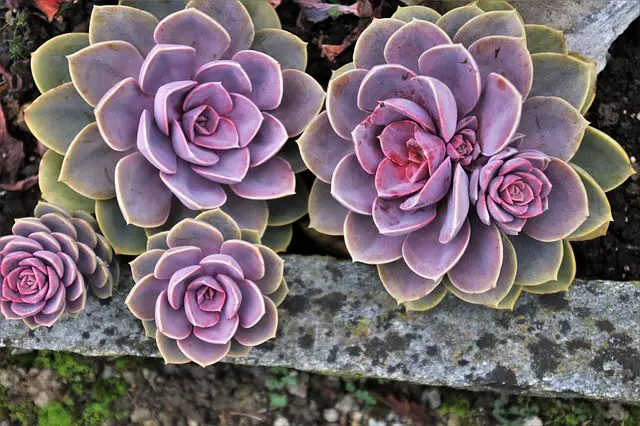
Picture via Pixabay
How to Tell if Your Succulent Gets Enough Light
Knowing how much sunlight your succulent needs isn’t an exact science, so you will need to keep an eye on it to tell how it’s doing. If your succulent has vibrant coloring, compact growth patterns, and firm stems and leaves, then everything is going well for it.
When a succulent starts going brown and develops a rough texture, you will need to move it to a location where it’s more sheltered from harsh light.
But if your succulent becomes leggy and stretches out in search of light, then it needs to be moved in a sunnier location. If you don’t have enough natural light in your home, you may use fluorescent grow lights for about 14-16 hours per day. The white light provides a wide spectrum of light that supplements natural lighting for your plants.
The Best Temperature For Succulents
Succulents thrive in a temperate climate with a temperature of about 60 to 90°F/16 to 32°C. Therefore, you should have no issues growing succulents indoors where it is warm enough for them. During winter, keep the plants in heated rooms so they can remain healthy during the cooler months.
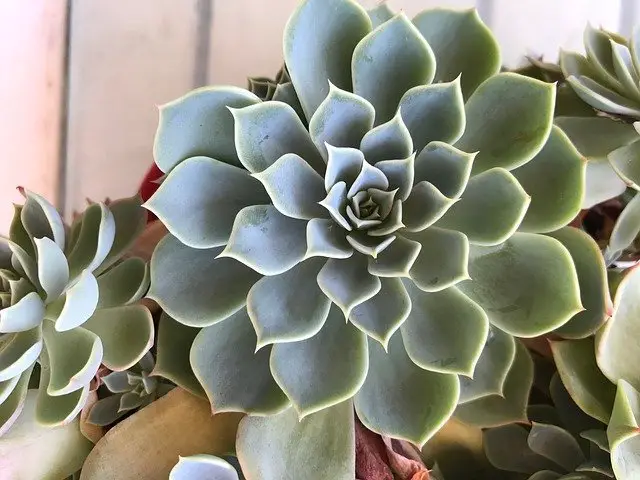
Picture via Pixabay
How to Take Care of a Succulent
Watering Tips
There’s a common misconception that succulents require a very small amount of water every now and then. But not all succulents are created equal and while some may survive under these harsh conditions, some won’t while others will certainly not thrive. It’s important to provide your succulent with enough water during their growing season, which is typically from spring to fall.
While growing, succulents should be watered at least once a week. During each watering, make sure to give the potting soil a good soaking. When the weather starts cooling and the day shortens, you can increase the interval between watering. This is when you need to let the potting soil mixture dry out between watering.
Do note that there are exceptions to these rules, as certain species of succulents are winter growers and will
need sufficient watering during the cooler months as well. Be sure to take a look at our guide on How To Water Succulents so you can learn more about their watering needs.
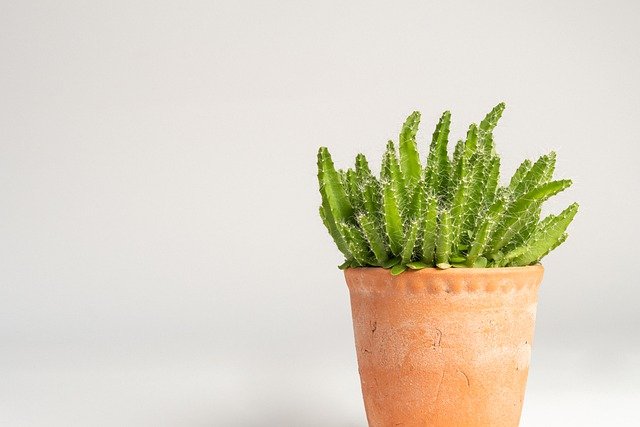
Picture via Pixabay
How To Fertilize Succulents
Potted succulents often require less fertilizer than other houseplants, but they do need periodic feeding. Fertilize your succulent when it’s emerging from its dormancy, which for most is spring. Avoid using too much fertilizer, as it will cause leaf and root rot problems. Choose the right blend and avoid overfeeding.
A light fertilizer such as diluted fish emulsion, manure tea, or a balanced fertilizer will keep your succulent healthy. To apply the fertilizer, first water the plant and then apply the liquid fertilizer until it begins to leave the pot.
Fertilizing succulents is optional, but they will perform better if you do. However, if you keep your succulents in a terrarium or in wreaths and want to keep them small, you should avoid feeding them.
How To Repot Succulents
Repotting is an essential part of caring for succulents because they need the fresh soil and you can also inspect and address any problems they may have with their root systems. Ideally, succulents should be repotted every year. If this seems too often, consider repotting when your plants show signs of unhappiness in their current soil. When your succulent looks out of proportion with its pot or has roots that are growing out through the drainage holes or surfacing from the top of the pot, then you can’t avoid not to repot.
To repot your succulents, first, remove the plant from its pot by inverting the pot and tapping it to loosen the soil. Next, carefully remove the old soil from the roots as to avoid damage to its fragile roots. If parts of the roots seem dead or dried out, you can prune them off. Finally, repot the succulent into the new, slightly larger pot. Cover the drainage holes with pot shards and then place the plant with the fresh soil mix. Do not water the plant soon after repotting because its roots need to heal. Watering the unhealed roots may lead to bacterial or fungal infections. Let the succulent rest out of direct sunlight for about a week before watering it.

Picture via Pixabay
Removing pests
Although most problems associated with succulents grown indoors are bacterial or fungal infections, these plants do sometimes get insect pest. The most common pests include mealybugs, scales, and aphids (or plant lice).
Mealybugs are tiny, elliptical insects that grow up to 3mm long and are gray or light brown. An early sign of mealy bugs is the white cotton-like substance on the plants. You can spot the substance on the leaves or between the joints of the succulent. To remove the mealybugs, apply rubbing alcohol anywhere you see the white substance with the help of Q-tip. Don’t worry, this won’t harm the plant.
Scales are some of the most common pests that attack succulents. If you see small, brown bumps on the plant, then you most likely have a scale problem. Remove the insects by hand or by hosing them off. Neem oil may also be used successfully. Alternatively, just as with mealybugs, scales too can be eliminated by using a Q-tip dipped in alcohol.
Aphids are small, generally green insects with teardrop-shaped bodies. To remove the pests, spray the affected areas of the plant with water or a mixture of soapy water. Neem oil has also been found effective in removing aphids, but make sure to dilute in water and use it at night so as to prevent sun damage.
Unfortunately, all pests are resistant and you may have to repeat the treatment a few times until you get rid of them completely. Repeat the treatments once a week until it is healed. Make sure to isolate the plant from the healthier ones to avoid contamination. You should also avoid using pesticides and insecticides because they may also kill beneficial bugs and predators that help maintain a healthy ecosystem.
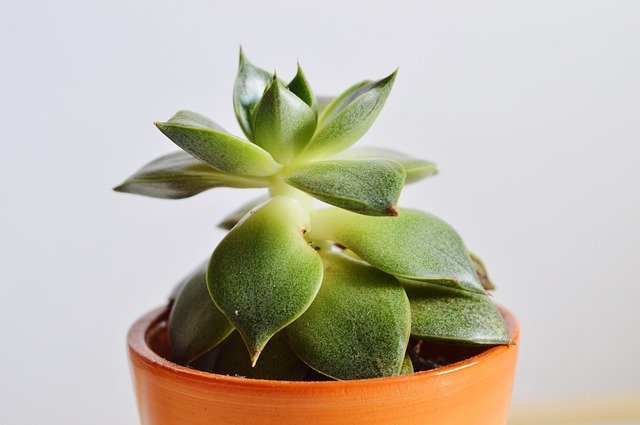
Picture via Pixabay
Propagating succulents
Propagating succulents is a breeze and the easiest and fastest way to do it is by using the plants you have. Here are four easy ways to propagate your plants:
- Plantlet removal. Remove the plantlets that have sprung up next to the mother plant. Some succulents drop the plantlets and just as with seeds, they take root where they fall.
- Root separation. This method is just a tiny bit more complex than diving. You will need to unearth the plant and gently pull apart the roots. Next, repot the separated clumps individually. Wait a day before watering.
- Leaf removal. Remove several leaves from the plant and allow them to dry out and grow roots. You can then plant them.
- Beheading. Cut the head of the plant and leave about an inch of stem attached. Let it dry out and grow roots, and then plant it. Don’t worry; the remaining stem of the beheaded succulent should grow new leaves.
These are just a few of the ways you can propagate your plant successfully. You can read more about How To Propagate Succulents to make sure you’re using the right techniques.
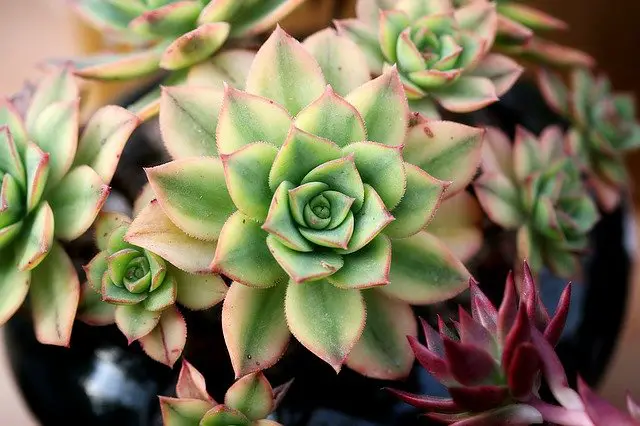
Picture via Pixabay
Best Succulents to Grow Indoors
It’s a common fact that some plants adapt quicker and better to indoor conditions than others, such as these Seven Best Indoor Plants. Succulents are generally easy to care for and can brighten any room, but there are a few species than are stand out as the best succulents to grow indoors.
- Burro’s tail (Sedum morganianum). This trailing succulent has superb gray-green or gray-blue leaves. It doesn’t bloom that often, but when it does, it produces pink or red flowers. Burro’s tail prefers medium to high light, but exposure to direct sunlight may burn its delicate leaves.
- Hens and chicks (Sempervivum tectorum). These are among the most popular succulents and take up very little space. The two plants that share the name of hens-and-chicks are Echeveria elegans and Sempervivum tectorum. Both produce what is commonly known as “chicks” – identical plants that grow near the mother plant.
- Aloe Vera. This medicinal plant is an attractive succulent that is also useful. It loves bright, indirect sunlight. Aloe Vera can be placed near a kitchen window for periodic use.
- Zebra Cactus (Haworthia fasciata). This succulent is native to the African continent and features distinctive horizontal white stripes. The beauty of it is that it requires a small space and little care.
- String of Bananas (Senecio Radicans). Another trailing succulent, this plant produces long tendrils of leaves. It looks gorgeous both on its own and with other succulent plants. While it is easy to care for, to grow thick and full, it does require regular pruning.
- Christmas Cactus (Schlumbergera x buckleyi). This is one of the plants that need no introduction. The beloved plant that is actually a succulent, not a cactus, has tropical origins. In order to grow the flower buds for its holiday blooms, it needs extended darkness for weeks prior.
Regardless of which type of plants you choose to grow indoors, it’s important to learn about the specific needs of each species to make sure your succulents grow and remain healthy throughout the years.

